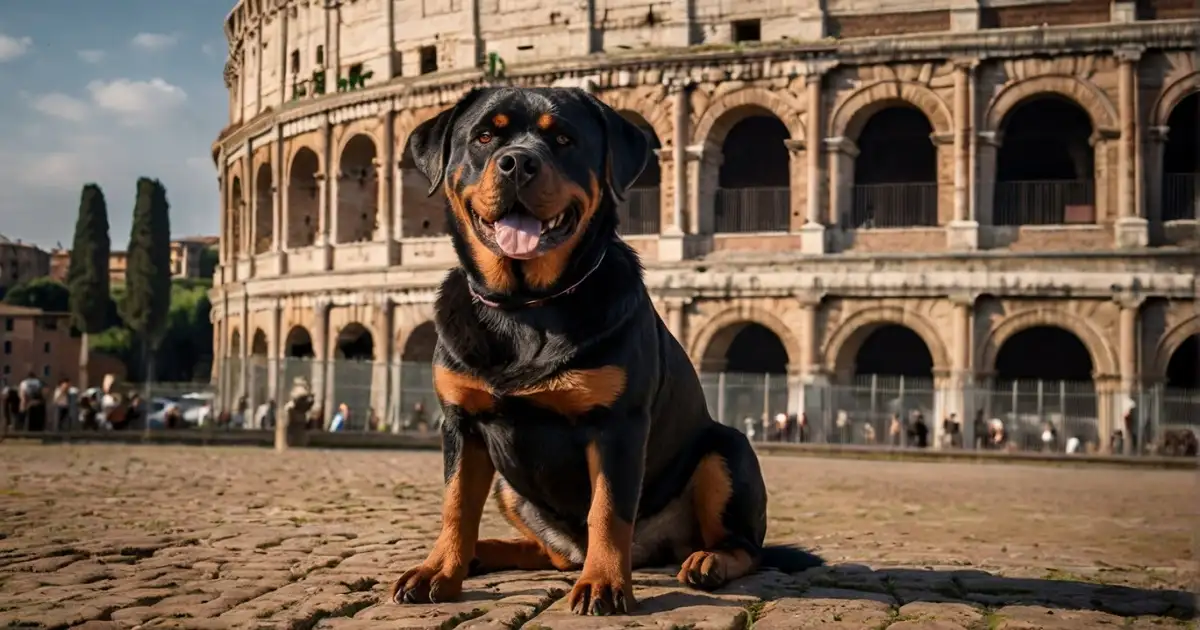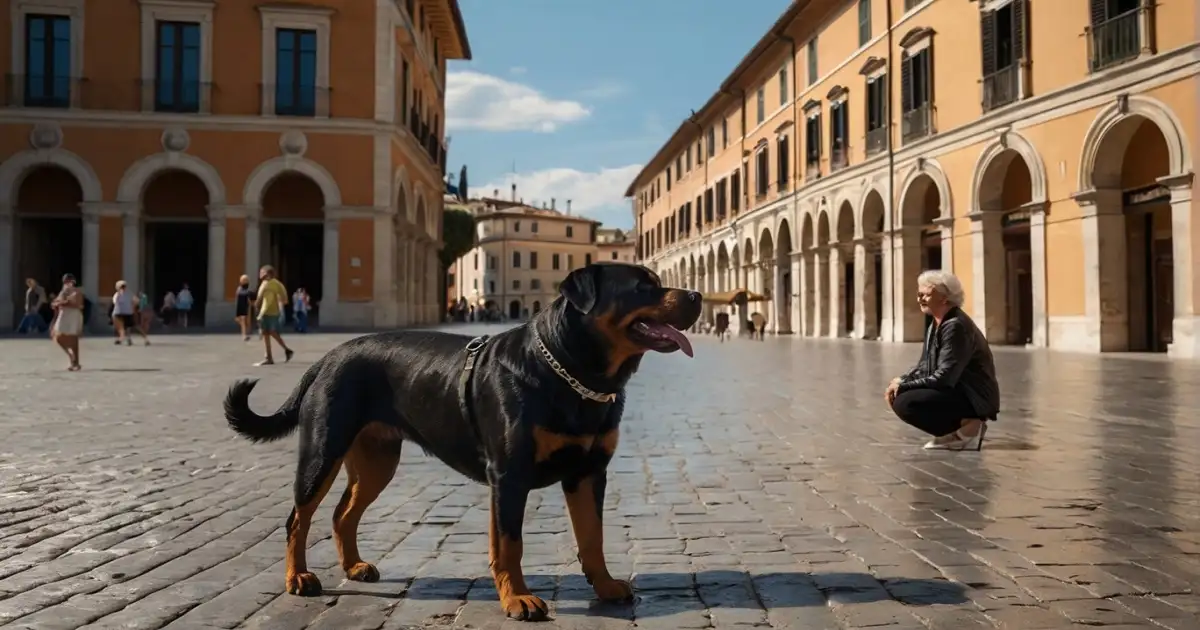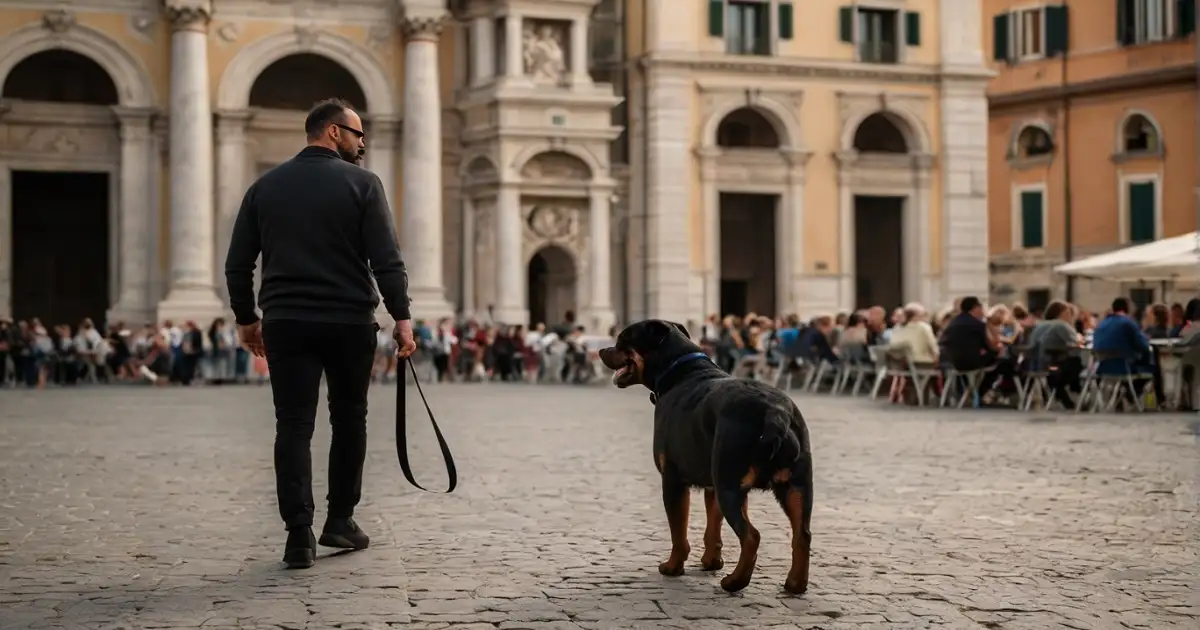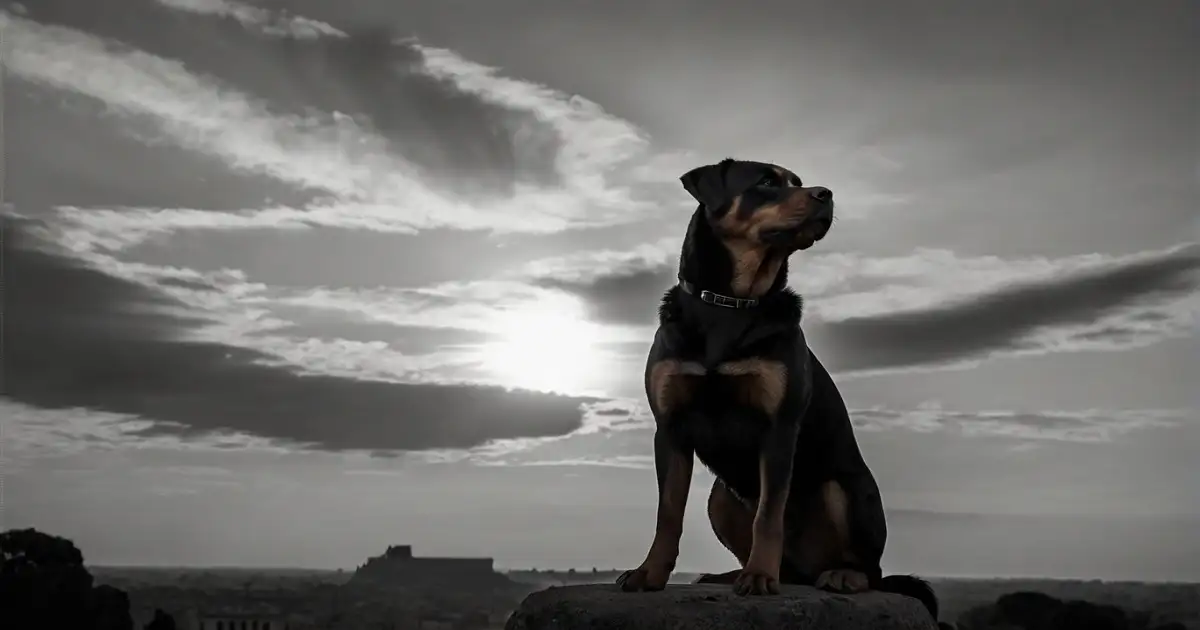Rome, the eternal city, is a tapestry woven with ancient history, cultural richness, and enduring traditions. At the heart of this captivating metropolis lies an unlikely hero – the Rottweiler, a breed often misunderstood yet inextricably linked to the city’s soul.
Beyond the stereotypes of aggression, these robust canines have etched their legacy as devoted guardians, unwavering companions, and a memorable part of Roman heritage.
Join us on an extraordinary journey as we unravel the tales of man’s best gladiator, exploring the origins, cultural significance, and the symbiotic bond between Rottweilers and the Eternal City.
Origins and History of Rottweilers
The legacy of the Rottweiler breed finds its origins intricately woven into the fabric of ancient Roman society. These formidable canines descended from the mighty descendants of the Roman cattle dogs known as the “Canis Romani.”
The robust Molossian dogs, revered for their unwavering loyalty, imposing stature, and exceptional guarding abilities, are the ancestors of this breed.
As the Roman Empire expanded, these ancestral dogs accompanied the legions, acting as sentinels, herders, and companions to the soldiers.
Their unwavering devotion and fearless nature earned them a place of honor within the ranks of the formidable Roman army, solidifying their role as the protectors of Rottweiler Rome.
The Rottweiler Renaissance: Revival in 19th Century Germany
The modern-day Rottweiler, familiar to us today, underwent a renaissance in the 19th century, although its roots stretch back to ancient Rome.
Butchers and cattle herders in the German town of Rottweil, located in the Swabian region, selectively bred these dogs to revive the ancient Roman lineage. The name “Rottweiler” was derived from this town, paying homage to the breed’s historical ties to the region.
With their exceptional strength, intelligence, and protective instincts, these dogs quickly gained popularity as versatile working companions, guarding livestock, pulling carts, and serving as trusted guardians of their human families.
Through this revival, the Rottweiler’s enduring bond with Rottweiler Rome was reignited, solidifying its status as a cultural icon, forever intertwined with the city’s rich tapestry.
Rottweilers in Rome: A Cultural Icon
In the annals of Rottweiler Rome, these powerful canines have come to symbolize much more than mere guardians or protectors.
Their unwavering loyalty, courage, and stoic demeanor have become emblematic of the indomitable Roman spirit – a spirit that has endured centuries of triumphs, adversities, and ever-evolving societal landscapes.
Throughout history, Rottweilers have stood as silent sentinels, safeguarding the city’s most treasured assets – its people, heritage, and way of life.
Their presence has become an indelible part of Rome’s cultural fabric, a constant reminder of the city’s resilience and ability to withstand the test of time.
Modern-Day Presence: Rottweilers in Roman Society
Even in the modern era, the Rottweiler’s presence in Rome remains a testament to the city’s enduring traditions.
These canines are vital in daily life, serving as loyal companions, protectors of homes and businesses, and even as ambassadors of Roman culture.
From the bustling streets of the historic center to the tranquil parks and piazzas, the sight of a Rottweiler is familiar, evoking a sense of pride and admiration among Romans.
Their image adorns everything from street art to souvenirs, cementing their place as an iconic symbol of the city’s rich tapestry.
In Rottweiler Rome, these beloved canines are more than just dogs; they are living embodiments of the city’s resilient spirit, reminding us of the unbreakable bond between humans and their four-legged companions that has endured throughout the ages.
Rottweiler Rome: Characteristics and Temperament
The Rottweiler breed commands attention and respect with its imposing physical presence. These muscular, well-built dogs are renowned for their impressive stature, broad heads, and powerful jaws, which were once essential for their historical roles as herders and guardians.
While their formidable appearance may seem intimidating at first glance, it reflects their inherent strength and unwavering vigilance – traits that have made them invaluable protectors throughout their history in Rottweiler Rome.
Temperamental Traits: Loyalty and Intelligence
Beyond their physical prowess, Rottweilers are renowned for their exceptional temperament, carefully cultivated and nurtured over centuries.
These dogs are known for their unwavering loyalty, forming deep bonds with their human families and exhibiting an innate desire to protect and serve.
Their remarkable intelligence allows them to excel in various roles, from guard dogs and police canines to service animals and beloved family companions.
This combination of loyalty and intelligence has made Rottweilers indispensable partners in Rome, where their presence has become an integral part of the city’s fabric.
Despite their imposing stature, Rottweilers are affectionate and gentle with their loved ones, particularly children.
However, their protective instincts remain ever-present, making them vigilant guardians who will not hesitate to defend their families from perceived threats.
In the streets and homes of Rottweiler Rome, these noble canines embody the perfect balance of strength, intelligence, and unwavering devotion, earning them a revered place in the hearts of Romans and visitors alike.
Rottweilers as Guardians of Rome
In ancient Rome, entrusted with safeguarding livestock and property, the Rottweilers’ ancestors established their legacy as guardians, a tradition that continues today.
Herding livestock and accompanying travelers on long journeys, these formidable canines, highly valued for their strength, loyalty, and unwavering commitment, protected their charges.
Their impressive size and imposing presence deterred potential threats, while their keen intelligence and protective instincts allowed them to assess and respond to any perceived dangers swiftly.
As Rome’s influence and territories expanded, so did the Rottweiler’s role, becoming an indispensable asset in ensuring the safety and prosperity of the Empire’s vast agricultural wealth.
Modern Roles: Guard Dogs of Rome’s Citizens
In contemporary Rottweiler Rome, these canines uphold their ancient duty as guardians, albeit in a more urbanized setting.
Many Roman families rely on Rottweilers as loyal companions and protectors of their homes and businesses, valuing their unwavering vigilance and ability to deter potential intruders.
Moreover, the breed’s reputation for courage and obedience has led to their widespread employment in law enforcement and security throughout the city.
Rottweilers often accompany police officers as formidable partners in maintaining public safety and order.
Whether patrolling the narrow alleys of historic neighborhoods or standing guard at private residences, these magnificent dogs embody the enduring spirit of protection woven into the fabric of Rome for centuries, ensuring its citizens’ continued safety and well-being.
Training and Care
Proper training and socialization were crucial for these powerful canines in Rome, even more so due to their strength.
Positive reinforcement training techniques and early socialization provide Rottweilers with the clear leadership and consistent guidance they thrive on.
Experienced Roman trainers emphasize the need for firm yet gentle handling, instilling a sense of respect and obedience while fostering a strong bond between dog and owner.
This approach ensures the development of well-mannered and responsive companions and reinforces the breed’s historical role as loyal and devoted guardians.
Nurturing the Bond: Care Tips for Rottweiler Owners
Caring for a Rottweiler in Rome requires more than just meeting their physical needs; it involves nurturing a deep and lasting bond built on trust, respect, and unwavering commitment.
These dogs thrive on human companionship and require ample attention, exercise, and mental stimulation to maintain their well-being.
Roman owners often involve their Rottweilers in various aspects of daily life, from leisurely walks through picturesque piazzas to active playtime in the city’s numerous parks and green spaces.
Regular grooming, proper nutrition, and access to adequate veterinary care are also essential components of responsible Rottweiler ownership in the Eternal City.
By understanding and meeting the unique needs of their Rottweiler companions, Roman owners can cultivate a solid and rewarding relationship that honors the breed’s ancient lineage and upholds their reputation as faithful protectors and beloved family members.
Challenges and Controversies
Despite their enduring legacy and cultural significance in Rottweiler Rome, these noble canines have faced their fair share of misconceptions and negative stereotypes.
Their imposing stature and formidable appearance have often led to unfair assumptions about their temperament and propensity for aggression.
However, responsible Rottweiler owners and advocates in Rome have worked tirelessly to dispel these myths, emphasizing the importance of proper training, socialization, and responsible ownership practices.
They underscore the breed’s natural protective instincts, which, when channeled appropriately, make them loyal and devoted companions.
Legal Issues: Rules and Restrictions in Rome
Like many cities worldwide, Rome has implemented specific regulations and restrictions surrounding the ownership and handling of certain dog breeds, including Rottweilers.
In ancient Rome, these measures, intended to promote public safety and responsible pet ownership, also sparked debates within the community.
While some view these regulations as necessary precautions, others argue that they unfairly target specific breeds and overlook the role of responsible ownership in shaping a dog’s behavior.
Navigating these legal complexities requires a nuanced understanding of local laws and a commitment to fostering a dialogue that balances public safety concerns with preserving the Rottweiler’s cultural significance in Rome.
By acknowledging and addressing these challenges head-on, Roman authorities, Rottweiler owners, and the broader community can work towards fostering a more inclusive and understanding environment for these iconic canines while ensuring all residents’ well-being and safety.
Rottweilers in Popular Culture
The Rottweiler’s presence in Rottweiler Rome has transcended mere functional roles, inspiring artistic and literary works that capture the essence of this breed’s enduring legacy.
From Renaissance paintings depicting Roman soldiers accompanied by their loyal canine companions to contemporary street art adorning the city’s walls, the Rottweiler has become a recurring motif in Rome’s cultural landscape.
Literary works, both fictional and non-fictional, have also explored the breed’s historical significance and profound impact on Roman society.
Authors have woven tales of courage, loyalty, and the unbreakable bond between humans and their four-legged guardians, further cementing the Rottweiler’s iconic status within the city’s cultural fabric.
Rottweilers in Film and Media: Shaping Perceptions
While artistic and literary representations have celebrated the Rottweiler’s legacy in Rome, their portrayal in film and media has been more nuanced, often reflecting societal perceptions and attitudes towards the breed at specific historical points.
In some instances, Rottweilers have been depicted as fearsome guardians, perpetuating stereotypes of aggression and intimidation.
However, more recent cinematic and television productions have sought to challenge these outdated notions, portraying Rottweilers as loyal companions, highly trainable protectors, and integral members of Roman families.
By critically examining these media representations, we understand how popular culture has been shaped by the public’s perception of Rottweilers in Rome, ultimately impacting the breed’s acceptance and integration within the city’s social fabric.
Rottweiler Rescue and Rehabilitation Efforts
In the heart of Rottweiler Rome, a network of compassionate individuals and organizations dedicated to rescuing and rehabilitating Rottweilers in need has emerged.
These rescue groups work tirelessly to provide safe havens for abandoned, neglected, or surrendered Rottweilers, offering them a chance at a new life filled with love and care.
Through their efforts, these organizations save individual dogs, strive to raise awareness about responsible pet ownership, and combat the negative stereotypes that often plague this breed.
They work closely with local authorities, veterinarians, and experienced trainers to ensure that each rescued Rottweiler receives medical attention, rehabilitation, and socialization to prepare them for their forever homes.
Rehabilitation Programs: Providing Second Chances
Recognizing the unique challenges faced by some Rottweilers, particularly those with behavioral issues or traumatic pasts, dedicated rehabilitation programs have been established within Rottweiler Rome.
These programs employ positive reinforcement training techniques, socialization exercises, and one-on-one attention to help these resilient canines overcome their fears and develop the confidence and trust necessary for successful adoption.
Experienced trainers and behaviorists work closely with each Rottweiler, tailoring their approach to the individual needs and histories of the dogs in their care.
By providing a nurturing and supportive environment, these rehabilitation programs aim to unlock the full potential of these dogs, allowing them to thrive as beloved companions and ambassadors for their breed.
Through these rescue and rehabilitation efforts, Rome continues to honor its longstanding tradition of embracing and celebrating the Rottweiler’s enduring spirit, ensuring every dog has a chance at a happy and fulfilling life, regardless of past circumstances.
Future Outlook: Preserving the Rottweiler Legacy in Rome
In the face of rapid urbanization and changing societal dynamics, preserving the Rottweiler’s rich heritage in Rottweiler Rome has become a priority for dedicated enthusiasts, breeders, and cultural organizations.
Concerted efforts are underway to maintain the breed’s genetic integrity, uphold responsible breeding practices, and promote educational initiatives celebrating the Rottweiler’s enduring bond with the Eternal City.
Through collaboration with local authorities, veterinary experts, and international breed organizations, Rome-based conservation groups are working tirelessly to ensure that future generations can continue to experience the joy and pride of owning and appreciating these magnificent canines.
It includes implementing measures to combat unethical breeding practices, promoting responsible ownership, and fostering a deeper understanding of the breed’s historical significance within the city’s cultural fabric.
Evolving Roles: Adapting to Modern Challenges
While the Rottweiler’s legacy in Rome is deeply rooted in its ancient roles as a guardian and protector, the breed’s future is inextricably tied to its ability to adapt to the ever-changing demands of modern urban life. As the city continues to evolve, so must the roles and responsibilities of these iconic canines.
From serving as therapy dogs in hospitals and nursing homes to assisting in search and rescue operations, the Rottweiler’s intelligence, loyalty, and versatility make them invaluable assets in addressing contemporary societal challenges.
Additionally, their presence in law enforcement and security remains crucial, ensuring Rome’s residents’ and visitors’ safety and well-being.
By embracing these evolving roles and fostering a deeper appreciation for the breed’s unique capabilities, the people of Rome can ensure that the Rottweiler’s legacy remains preserved and actively celebrated as an integral part of the city’s vibrant future.
Conclusion
As we journey through the annals of Rottweiler Rome, one truth becomes abundantly clear – the bond between these magnificent canines and the Eternal City transcends mere domestication. It is a bond forged through centuries of loyalty, courage, and an unwavering commitment to protecting and serving those they hold dear.
From their ancient roots as the formidable guardians of Roman cattle to their modern-day roles as devoted companions and protectors, Rottweilers have woven themselves into the very fabric of Rome’s rich cultural tapestry.
Their imposing presence, unparalleled strength, and fierce devotion have become emblematic of the city’s resilient spirit, which has endured through the triumphs and tribulations of history.
Embracing the Legacy: Rottweilers as Timeless Guardians
As we look towards the future, we must embrace and celebrate the Rottweiler’s enduring legacy in Rottweiler Rome.
These noble canines embody the city’s unyielding determination, reminding us that true strength lies in physical prowess and the unwavering bonds of loyalty and love.
Whether patrolling the ancient streets, standing guard over cherished homes and businesses, or offering unconditional companionship, Rottweilers continue to uphold their sacred duty as the guardians of Rome.
Their presence is a testament to the enduring power of the human-animal connection, a bond that transcends language, culture, and time.
The Roman people forever revere the Rottweiler as a symbol of courage, resilience, and the unbreakable spirit that has defined the Eternal City for millennia.
Their legacy, a testament to the unwavering loyalty that can blossom between humans and animals, inspires future generations.
FAQs (Frequently Asked Questions)
Are Rottweilers aggressive by nature?
- Proper training, socialization, and upbringing influence Rottweiler’s behavior significantly. Rottweilers are not inherently aggressive dogs. Obedience training and responsible ownership can positively channel Rottweilers’ natural protective instincts. With guidance and care, Rottweilers can make loyal, affectionate family companions.
How do Rottweilers fare in Rome’s climate?
- Rottweilers are a versatile breed that adapts well to Rome’s generally mild Mediterranean climate. Their short double coat provides insulation without excessive heat buildup. Owners should take precautions like providing shade and plenty of water on hotter days. The breed can also tolerate cooler temperatures due to their thick coats. Proper climate management allows Rottweilers to thrive in Rome.
What is the average lifespan of a Rottweiler?
- With proper care, nutrition, and veterinary attention, the average lifespan of a Rottweiler is 8-10 years. Some may live longer, up to 12 years, depending on their genetic predisposition and overall health management by owners. Size and weight can impact lifespan. Reputable breeders, regular exercise, and preventive care contribute to Rottweilers reaching their optimum longevity potential.
Can Rottweilers coexist with other pets in a Roman household?
- Yes, with proper introductions and training, Rottweilers can get along well with other dogs and pets when raised together from a young age. Due to their territorial nature towards unfamiliar animals, early socialization is vital for Rottweilers. Owners should supervise gradual, positive introductions to prevent potential issues. With their family-oriented temperaments, Rottweilers can bond closely with other household pets.
Are Rottweilers suitable for apartment living in Rome?
- While the Rottweiler is a large breed, they can adapt well to apartment living in Rome with sufficient daily exercise and mental stimulation provided by their owners. Access to parks and open spaces allows them to expend energy safely. Proper training to manage barking and other nuisance behaviors is also essential for harmonious apartment life.









